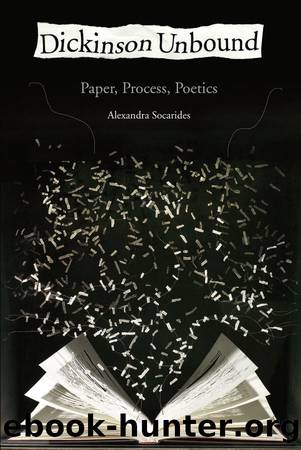Dickinson Unbound by Alexandra Socarides;

Author:Alexandra Socarides; [Socarides, Alexandra]
Language: eng
Format: epub
ISBN: 9780199380237
Publisher: OxfordUP
Published: 2014-09-18T03:36:34+00:00
Figure 4.1
âSet 2.â Courtesy, Archives & Special Collections, Amherst College.
While Mitchell makes the difference between fascicles and sets into something more minor than it is (and therefore claims the poems in the âsetsâ as those that we might read along whatever lines we establish for reading the poems in the fascicles), others acknowledge the difference as major and are left with a different conundrum. Sharon Cameron, for instance, declares âthe importance of a different understanding of those poems intended to be bound than of those for which no binding appears to have been intended.â9 The result of acknowledging that âthe sets have many of the characteristics of the fascicles except that they were not stab-bound and tiedâ is that Cameron leaves them out of her consideration of the fascicles.10 Because they are so different from the fascicles, they cannot be considered alongside them in her study. But just because there is no obvious structure to these materials (and that whatever structure might exist is complicated by the existence of the fascicles to which they are related but are not the same as), does not mean that Dickinsonâs loose sheetsâthe term I will use instead of âsetsââare incomprehensible. But how are we to understand these materials that are connected to, even if almost entirely different from, the fascicles?
Current critical approaches to this stage in Dickinsonâs writing invite us to treat the change in her practices as the result of an exterior pressure, one that is often rendered as some event that took place in Dickinsonâs lifeâfor instance, her motherâs stroke, Dickinsonâs own vision trouble, or the end of the Civil War. Along the lines of these explanations, Dickinson found herself in a changed position in relation to her writing, copying, and sewing processes.11 Other explanations, both of which Franklin suggests, are that Dickinson came to find the sewn fascicles difficult to use and that at this point in Dickinsonâs life âher need for self-publication declined, and with it the desire to leave an organized legacy for the world.â12 Habegger supports the second of these explanations when he calls attention to the issues of self-editing and preservation that these materials bring into focus: âFrom 1871 to 1875, resuming her practice of 1865, Dickinson made clean copies of her poetry on folded sets of stationery. This self-editing, however, was more selective and sporadic than the systematic preservation of 1858â1865, when she preserved the vast preponderance of her work in manuscript books and sets. In the seventies the proportions were reversed, two-thirds of her poems never being collected.â13 Both theories are faulty because Dickinson continued to write an enormous number of poems and letters during these years, and although she altered this specific element of her process, she maintained her customary drafting and copying process. While it may be true that Dickinson wanted to be able to browse and find poems more quickly, it remains entirely unclear why this would have been initially easier to do when sheets were sewn together but then eventually easier when loose.
Download
This site does not store any files on its server. We only index and link to content provided by other sites. Please contact the content providers to delete copyright contents if any and email us, we'll remove relevant links or contents immediately.
The Power of Myth by Joseph Campbell & Bill Moyers(925)
Half Moon Bay by Jonathan Kellerman & Jesse Kellerman(911)
A Social History of the Media by Peter Burke & Peter Burke(882)
Inseparable by Emma Donoghue(844)
The Nets of Modernism: Henry James, Virginia Woolf, James Joyce, and Sigmund Freud by Maud Ellmann(739)
The Spike by Mark Humphries;(719)
A Theory of Narrative Drawing by Simon Grennan(707)
The Complete Correspondence 1928-1940 by Theodor W. Adorno & Walter Benjamin(704)
Ideology by Eagleton Terry;(659)
Bodies from the Library 3 by Tony Medawar(649)
Culture by Terry Eagleton(646)
World Philology by(645)
Farnsworth's Classical English Rhetoric by Ward Farnsworth(641)
A Reader’s Companion to J. D. Salinger’s The Catcher in the Rye by Peter Beidler(614)
Adam Smith by Jonathan Conlin(608)
High Albania by M. Edith Durham(592)
Game of Thrones and Philosophy by William Irwin(592)
Comic Genius: Portraits of Funny People by(581)
Monkey King by Wu Cheng'en(577)
